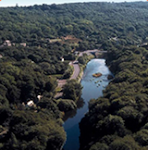The day was overcast with a wind straight out of the Arctic – was snow forecast? It seemed a possibility. We wrapped up well and set off, for once ignoring the car parking area. The plan, yes, we did have a plan, was to follow the footpath alongside the Wesley Brook to Kemberton Mill and then through King Charles’ Wood to Evelith Mill before returning by the same route or an alternative path.
We crossed the brook using the elongate Oldforge Bridge then followed the course of the brook using the footpath through the very pleasant wood. On emerging from the wood we crossed into a sheep field and had lunch. We were still in sight of where we had parked the cars about 400yards away!
The verge of the bridge and the wood provided plenty of entertainment : craneflies and weevils doing what most animals do in the spring; plants for identification and lots of other wee beasties most of which were in families that we could not identify, unfortunately – but we did manage to name a few. No shieldbugs – were we cursed?
It was in this wood that one of our group managed for the first time to “net” and “pot” a cranefly successfully, a feat that he was keen that the rest of world should be aware off.
We shivered through lunch, even our bare-legged colleague who had goose-bumps on his goose-bumps was forced to wrap up. But what was that in the sky – BLUE – yes, the threat of snow was receding and there was a chance that we might get some sunshine. However the wind still blew and we discussed the merits of Centigrade and Fahrenheit for judging how warm or cold it was.
After lunch we made our way slowly up the field to a small area of long grass and other tall plants. The sun came out and when we found areas that were sheltered from the wind there was plenty of wildlife to observe. And the curse was broken as we found two more species of shieldbug – Green and Forest/Red-legged. I was overwhelmed by hoverflies and craneflies which the other members of the group kept catching for me.
Time flies when you are enjoying yourself. We had “walked” about half a mile in nearly 5 hours. The first objective – Kemberton Mill - was still half a mile away, so the plan was abandoned and we headed for home. As these events are advertised as Invertebrately Challenged Tetrad Walks I hope no one will sue me under the Trades Descriptions Act. Getting back to the cars was much quicker!
Did we miss the opportunity to scour the car park? Don’t be silly, we spent the next 45 minutes or so inspecting the small but active sandstone cliff face which was now bathed in warm sunshine. Many bees were using holes in the rock and lurking nearby was a Jewel wasp.
It was here that we found the fourth shieldbug of the day, a Hairy/Sloe bug.
It had been a good day.
Keith Fowler



































